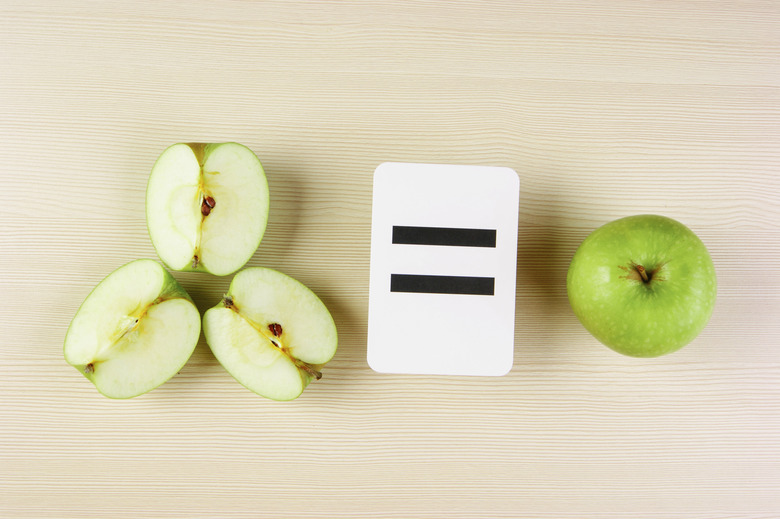How To Find The Least Common Denominator Of Two Fractions
Adding or subtracting fractions requires a common denominator, which requires you to create equivalent fractions using the original fractions given in a problem. There are two basic methods to finding these equivalent fractions — using prime factorization or finding common multiples. Either method will allow you to solve the original problem.
Using Factoring to Find the LCD
Using Factoring to Find the LCD
One method of finding the least common denominator of fractions, or the LCD, is to determine the prime factorization of each denominator. For example, if you have two fractions with denominators of 6 and 8, begin by creating the factors for 6. Determine that the two prime factors of 6 are 2 and 3. Next, determine that the prime factors of 8 are 2, 2 and 2, which is simplified at 2^3. To find the LCD, use all of the factors in the first number, in this case 2 and 3, and any factors from the second number that were not already used. We have already used a single 2, but we must use the 2 and 2 that remain from the prime factorization of 8. This gives us factors of 2, 2, 2 and 3. We multiply all of the factors together to find an LCD of 24.
Finding the Least Common Multiple
Finding the Least Common Multiple
A second method for finding the LCD, particularly with fractions that have smaller denominators, is to begin by finding the least common multiple, or LCM. Begin by listing the two denominators and multiplying each one by the numbers 1 through 10. In our previous example, using 6 and 8, begin with 6 and create a list of multiples by multiplying by 1, 2, 3, 4, 5 and so on. Completing the list through 10 gives you 6, 12, 18, 24, 30, 36, 42, 48, 56, 54 and 60. Performing the same task with the number 8 gives you 8, 16, 24, 32, 40, 48, 56, 64, 72 and 80. The least common multiple is the lowest value that appears in both lists. In this case, it is 24.
More Complex Denominators
More Complex Denominators
With a denominator that contains variables and exponents, the procedure for finding the LCD begins with factorization. For example, if the two denominators are 4ab and 2a^2, begin by factoring 4ab. The four factors are 2, 2, a and b. The factors of 2a^2 are 2, a and a. Similar to the numerals-only version of the problem, we take all of the factors of the first denominator and the factors of the second denominator that do not appear in the first. This gives you 2, 2, a, b, and a. Note that we added another "a" because the second denominator has two "a" factors. Multiply all of the factors back together and find a common denominator of 4a^2b.
Converting the Fraction to the LCD
Converting the Fraction to the LCD
Determining the common denominator or least common multiple is the first step in creating two equivalent fractions with a least common denominator. In the first two examples, the denominators were 6 and 8, which you determined have an LCD of 24. To convert each, find a factor that when multiplied by the given denominator will result in 24. In the case of 6, you multiply by 4 to get 24. In the case of 8, you multiply by 3 to get 24. It is important to determine the factor needed to multiply because it must also be multiplied with the numerator to find an equivalent fraction.
Cite This Article
MLA
Sosnowski, Jana. "How To Find The Least Common Denominator Of Two Fractions" sciencing.com, https://www.sciencing.com/find-least-common-denominator-two-2338102/. 24 April 2017.
APA
Sosnowski, Jana. (2017, April 24). How To Find The Least Common Denominator Of Two Fractions. sciencing.com. Retrieved from https://www.sciencing.com/find-least-common-denominator-two-2338102/
Chicago
Sosnowski, Jana. How To Find The Least Common Denominator Of Two Fractions last modified March 24, 2022. https://www.sciencing.com/find-least-common-denominator-two-2338102/
